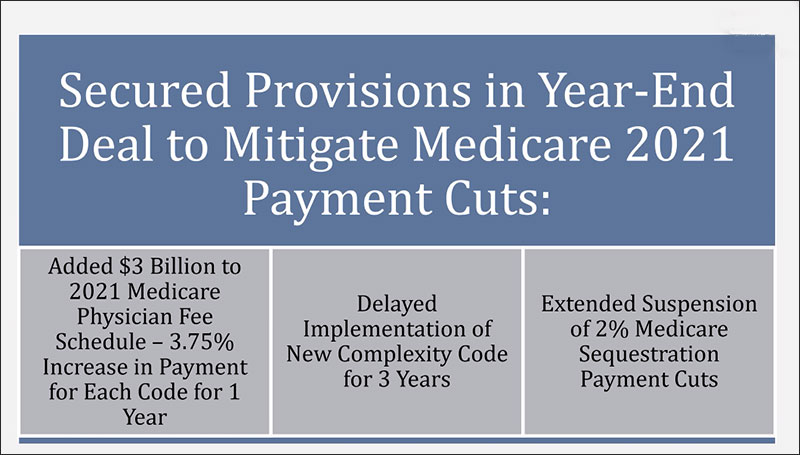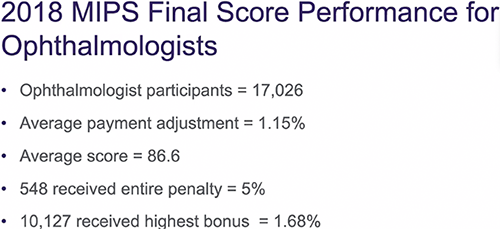Despite the unprecedented challenges of 2020, the Academy was able to achieve several legislative victories for ophthalmology over the past year.
We remain vigilant and aware that there are many more battles on the horizon in 2021. The American Academy of Ophthalmology held its annual (virtual) Federal Affairs Secretariat meeting on Jan. 30 to recap the major events of the previous year and set our agenda going forward as an organization.
The Academy and our advocacy partners are ready to work with the new administration and our colleagues in all fields of medicine to protect our profession and be an active participant in the changing health care landscape.
5 Big Wins
1. Delaying Medicare Cuts to Ophthalmology
In November 2019, the Centers for Medicare & Medicaid Services finalized policy changes for evaluation and management (E/M) coding services that would have resulted in an estimated 6% to 10% Medicare payment cut for ophthalmologists beginning on Jan 1.
The scheduled fee changes were based on the principle of budget neutrality, which disproportionately affected surgical specialists and subspecialists in reimbursements. The Academy had made reversing these cuts a top priority and partnered with other surgical specialists to form the Surgical Care Coalition to lobby for changes.
The combined advocacy efforts resulted in a correction being included in the pandemic relief package that was passed in December 2020. Congress included provisions in the year end package that added $3 billion to Medicare Physician Fee Schedule in 2021 — a 3.75% increase in each code for one year.
The act also delays the implementation of a new complexity code that would make billing more burdensome and extends the suspension of the 2% Medicare sequestration cuts until March 2021 (Figure 1, below).
An American Medical Association analysis shows that ophthalmology’s increase in reimbursements for 2021 increased overall by 1% as a result of the legislation.

2. More Physicians in Congress (including one of our own!)
The 2020 election brought a few new fresh faces to Congress. With the support of the academy’s political action committee, OPHTHPAC®, three new physicians joined the 117th Congress, bringing the total number to 17. OPHTHPAC has been a key contributor to current physician members in Congress and supported 23 physician candidates running for office in the last election cycle.
These members along with other OPHTHPAC champions have been instrumental in advancing the Academy’s legislative priorities such as reversing Medicare cuts and reduction of administrative burdens on physicians.
House of Representatives
Mariannette Miller-Meeks, MD, R-Iowa*. Dr. Miller-Meeks narrowly won her congressional district by six votes. Her Democratic challenger, Rita Hart, is challenging the results of the election given the razor-thin margin. However, Dr. Miller-Meeks was provisionally sworn in by the Speaker of the House. This is a big victory for the Academy since Dr. Miller-Meeks will be the second ophthalmologist serving in Congress. Dr. Miller-Meeks previously served as head of Iowa’s state health department and was instrumental in stopping optometric surgical scope expansion legislation.
Ronny Jackson, MD, R-Texas. Dr. Jackson is a trained emergency room physician and formal Navy Veteran. With his background and interests, he is likely to serve on the House Veterans Affairs and Armed Services Committee.
Senate
Roger Marshall, MD, R-Kansas. Dr. Marshall previously served in the House and won the open U.S. Senate seat in Kansas. During his tenure in the House, Dr. Marshall was a great friend to ophthalmology, sponsoring Academy backed legislation to reduce prior authorization burdens for Medicare Advantage plans. Dr. Marshall also played a key role in helping to avert Medicare payment cuts that were set to go into effect this year.
3. Paycheck Protection Program (PPP)
The Academy has been active in ensuring its members have access to funds through the PPP. The PPP provides small businesses an opportunity to secure loans from the government if they can demonstrate a revenue reduction of 25%. Eligible businesses must have 300 or fewer employees and several provisions allow for loan forgiveness if the funds are allocated toward payroll costs. Since the announcement of the program, the Academy has provided resources and dedicated personnel to ensure its members can take full advantage of these government programs.
4. IRIS® Registry
The IRIS Registry continues to be a huge success for ophthalmology. Ophthalmologists are one of the most successful physician groups at meeting Merit-Based Incentive Payment System (MIPS) requirements.
No physicians participating in the IRIS registry were penalized from MIPS and only 5% of Ophthalmologists overall did not meet the requirements. (Figure 2, below). In 2020, the IRIS registry reporting to MIPS was estimated to save $280 million dollars for US Academy members — an average of $28,121 per member. The overall MIPS criteria to avoid penalization will continue to increase in 2021 for all physicians and ophthalmology remains well-positioned with IRIS registry to avoid these cuts.

5. Avastin Reimbursement
Using the IRIS registry data, the Academy was able to advocate for increased reimbursement for Avastin usage from two major Medicare administrative contractors (MACs). IRIS registry data on anti-VEGF utilization trends showed a drop of market share for Avastin in Medicare fee-for-service from 45% in 2018 to 36% at the end of 2019.
The Academy warned CMS this would be likely as Medicare reimbursement rates continued to be sub-par. New federal requirements on syringes last year caused an Avastin shortage which further drove costs higher. The Academy again lobbied CMS to put pressure on MACs which set reimbursement rates for Avastin to increase their reimbursement or more providers would opt to use costlier medications. Two major MACs — Noridian and WPS — increased their reimbursement with the hope that more will follow suit.
Watch for part 2 of “The Big Kid’s Table: 3 Looming Battles in 2021” next month, when Dr. Krivochenitser looks ahead at the challenges that face ophthalmology.
 |
About the author: Roman Krivochenitser, MD, is an ophthalmologist at the Colorado Eye Institute in Colorado Springs, Colo. He completed his residency at the University of Wisconsin and a glaucoma fellowship at the Kellogg Eye Center at the University of Michigan. As a resident, Dr. Krivochenitser was instrumental in establishing a young ophthalmologists group in Wisconsin and was a three-time Academy Advocacy Ambassador Program participant. He currently serves on the YO Advocacy Subcommittee.
|